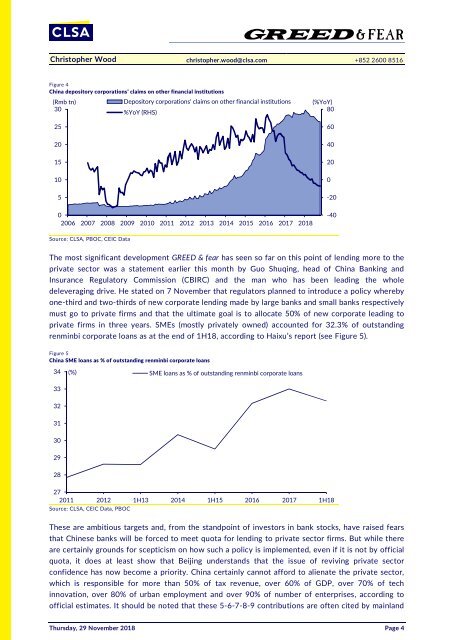Create successful ePaper yourself
Turn your PDF publications into a flip-book with our unique Google optimized e-Paper software.
Christopher Wood christopher.wood@clsa.com +852 2600 8516<br />
Figure 4<br />
China depository corporations’ claims on other financial institutions<br />
(Rmb tn)<br />
Depository corporations' claims on other financial institutions<br />
30<br />
%YoY (RHS)<br />
25<br />
20<br />
15<br />
10<br />
5<br />
(%YoY)<br />
80<br />
60<br />
40<br />
20<br />
0<br />
-20<br />
0<br />
2006 2007 2008 2009 2010 2011 2012 2013 2014 2015 2016 2017 2018<br />
-40<br />
Source: CLSA, PBOC, CEIC Data<br />
The most significant development GREED & fear has seen so far on this point of lending more to the<br />
private sector was a statement earlier this month by Guo Shuqing, head of China Banking and<br />
Insurance Regulatory Commission (CBIRC) and the man who has been leading the whole<br />
deleveraging drive. He stated on 7 November that regulators planned to introduce a policy whereby<br />
one-third and two-thirds of new corporate lending made by large banks and small banks respectively<br />
must go to private firms and that the ultimate goal is to allocate 50% of new corporate leading to<br />
private firms in three years. SMEs (mostly privately owned) accounted for 32.3% of outstanding<br />
renminbi corporate loans as at the end of 1H18, according to Haixu’s report (see Figure 5).<br />
Figure 5<br />
China SME loans as % of outstanding renminbi corporate loans<br />
34<br />
(%) SME loans as % of outstanding renminbi corporate loans<br />
33<br />
32<br />
31<br />
30<br />
29<br />
28<br />
27<br />
2011 2012 1H13 2014 1H15 2016 2017 1H18<br />
Source: CLSA, CEIC Data, PBOC<br />
These are ambitious targets and, from the standpoint of investors in bank stocks, have raised fears<br />
that Chinese banks will be forced to meet quota for lending to private sector firms. But while there<br />
are certainly grounds for scepticism on how such a policy is implemented, even if it is not by official<br />
quota, it does at least show that Beijing understands that the issue of reviving private sector<br />
confidence has now become a priority. China certainly cannot afford to alienate the private sector,<br />
which is responsible for more than 50% of tax revenue, over 60% of GDP, over 70% of tech<br />
innovation, over 80% of urban employment and over 90% of number of enterprises, according to<br />
official estimates. It should be noted that these 5-6-7-8-9 contributions are often cited by mainland<br />
Thursday, 29 November 2018 Page 4
















